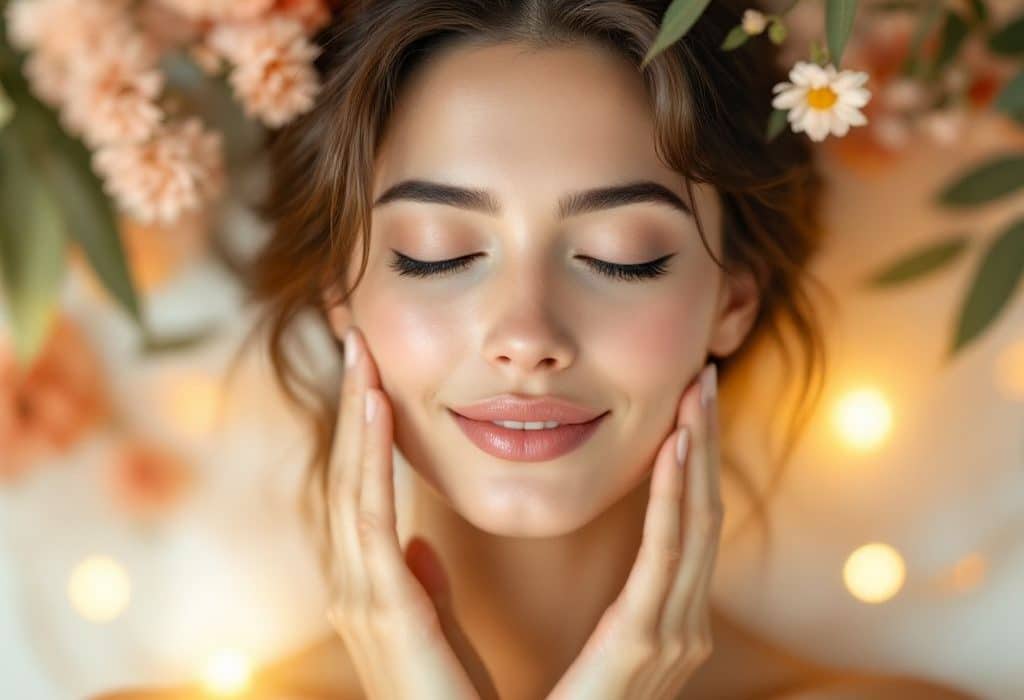Ever feel like your skin needs a little extra something, but you want to keep it all-natural? Or perhaps your energy seems a bit off lately and you can’t quite put your finger on why. If any of these ring a bell, let me tell you, you’re not alone. We all have those moments where we crave a simple, gentle method to enhance our natural skin care routine and feel more balanced. Enter the world of face tapping. Trust me, once you dive into this, it’ll become your go-to ritual.
What Exactly is the Face Tapping Method?
Alright, let’s get into it. Face tapping isn’t just a random face massage. It’s an approach rooted in energy flow, similar to therapies like acupuncture or acupressure, but without the needles. Just your fingers, a little technique, and the willingness to embrace a natural skin care method.
Think of it as lightly tapping your face with your fingertips, following a sequence that’s designed to encourage energy to flow better through your body. It’s like giving your facial circuit a little tune-up.
Why Should You Try Face Tapping?
You’re probably wondering, “Does tapping my face really make a difference?” Well, let’s break this down. Face tapping has benefits like:
- Enhanced Circulation: By stimulating facial blood flow, tapping helps your skin look more vibrant and youthful.
- Stress Reduction: It encourages relaxation — and less stress means fewer skin flare-ups.
- Natural Glow: No need for expensive lotions or procedures — tapping helps release toxins and lets your skin breathe.
Notice how face tapping aligns perfectly with a natural skin care strategy? It’s about letting your body’s energy do the hard work.
How to Do Face Tapping: A Step-by-Step Guide

Ready to give it a whirl? It’s way simpler than you might think. Here’s how to do it.
Step 1: Prepare Your Space
Before you start tapping, set the mood. A quiet, comfortable room is ideal. Dim the lights if you want, just make sure you feel at ease. Grab a comfortable chair or settle down in a serene spot. It’s time for a little me-time.
Step 2: Cleanse Your Skin
Of course, we want a fresh canvas. Wash your face with your preferred cleanser or follow any pre-existing natural skin care routine you have. Removing makeup and impurities ensures your tapping is effective.
Step 3: Warm-Up Tapping
Start by gently clapping your hands together for a few minutes. This warms them up. Think of it as telling your hands, “Wake up, we’re about to do something great!” Then, begin tapping lightly from your hairline to your chin, moving in a circular motion along your cheeks.
Step 4: Execute the Tapping Sequence
Now, dive into the nitty-gritty. Here’s a suggested sequence:
- Forehead Taps: Use the index finger and middle finger of both hands. Start at the center of your forehead and move outward towards the temples.
- Eye Area Tapping: Around your eyes, go softer. Use your ring finger to gently tap around your eyes in a circle, starting from the outer corner, moving underneath, and back around.
- Cheekbones and Jawline: Following the cheek contour, tap outward. Go from the center of your face beneath the eyes to your ears, and then move to your jawline.
- Chin and Mouth Contour: Tap around your mouth and chin in a small circular motion.
Step 5: Deep Breathing

Once you’ve completed your tapping session, take a few deep breaths. Inhale slowly through your nose, and exhale through your mouth. Breathing right afterward helps lock in that serene sensation granted by increased energy circulation.
Step 6: Repeat Regularly
Here’s a not-so-secret secret: consistency is key. Aim to incorporate this into your daily routine or at least a few times a week.
Face Tapping for Different Skin Types
Not everyone’s skin reacts the same, and that’s okay. Here’s how to adjust the tapping method for various skin types:
- Oily Skin: Use a lighter touch. Your skin might get more benefit from a gentle stimulus to avoid excess oil production.
- Dry Skin: You might enjoy a more extended session with a nourishing facial oil to add moisture.
- Sensitive Skin: Be cautious and adapt the pressure to what feels comfortable. If there’s any discomfort, reduce the frequency until your skin adjusts.
Face Tapping with Natural Skin Care Products
Pair your tapping routine with effective natural skin care products to enhance the benefits. Consider integrating:
- Natural Oils: Using oils like jojoba or rosehip can augment the effects. Just a few drops on your fingertips can do wonders and add even more nourishment to your skin.
- Herbal Mists: Spritz a gentle face mist before and after tapping for added hydration and to soothe your skin.
- DIY Serum: Combine simple ingredients like aloe vera and vitamin E for a homemade serum boost.
These natural enhancers don’t just complement face tapping—they work synergistically!

Common Mistakes and How to Avoid Them
I’ve learned that with simple techniques like face tapping, it’s easy to overlook the basics. Here are few common missteps you might run into:
- Using Too Much Force: Tapping should be gentle. If you feel pain or any discomfort, you’re likely tapping too hard.
- Ignoring Consistency: Like most beauty practices, the more consistent you are, the better the results.
- Skipping Moisturizing: After tapping, your skin will be ready to soak up moisturizers. Don’t miss this step, especially if dry skin is a concern.
Let’s Recap and Sum It Up
It’s kind of amazing how something so simple can have such positive effects, right? Face tapping is about tapping into that internal energy, aligning with your skin’s natural mechanics, and connecting the dots between body and mind. We’ve covered the foundations, benefits, a step-by-step guide, and some extra tips to help you make the most of this natural skin care tactic.
So, why not give it a try? You might find it to be more than a beauty trick. It could become a precious ritual in your quest to balance your skin’s glow and your inner energy alike.
Remember, patience and consistency will do wonders. Soon enough, you’ll notice not just softer skin but a brighter energy coursing through your face and into your daily life. Embrace the tap and the flow will follow!
Frequently Asked Questions
What are the benefits of using natural ingredients in skin care?
Using natural ingredients in skin care offers several benefits, including hydration, protection from environmental stressors, and anti-inflammatory properties. Natural ingredients like aloe vera, chamomile, and lavender provide gentle yet effective cleansing and protection for the skin. They are also free from harmful chemicals and toxins, making them suitable for sensitive or allergy-prone skin[1][3][5).
How do natural ingredients differ from synthetic ingredients in skin care?
Natural ingredients differ from synthetic ingredients in that they are sourced from plant-based materials and are minimally processed. Natural ingredients are rich in vitamins, antioxidants, and other beneficial compounds that can nourish and protect the skin. Unlike synthetic ingredients, natural ingredients are generally gentler and less irritating, and they have a lower environmental impact[1][3][5).
What natural ingredients are effective for anti-aging and skin hydration?
Natural ingredients such as aloe vera, jojoba oil, green tea, and rosehip oil are highly effective for anti-aging and skin hydration. Aloe vera promotes collagen production, while jojoba oil and rosehip oil provide deep hydration and improve skin elasticity. Green tea is rich in antioxidants that help protect the skin from aging and environmental damage[1][3][5).
Are natural skin care products suitable for sensitive skin?
Yes, natural skin care products are often suitable for sensitive skin. Natural ingredients like coconut oil, shea butter, and sandalwood powder are gentle and less likely to cause skin irritation compared to products containing harsh chemicals, artificial colors, or other by-products. These natural ingredients can help soothe and nourish sensitive skin without causing adverse reactions[1][3][5).
References

